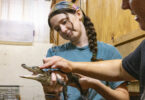Athens, Ga. – Each year, the influenza virus evolves. And each year, public health officials try to predict what the new strain will be and how it will affect the population in order to best combat it.
A new study by an international team of researchers, led by assistant professor Andrew W. Park, who holds a joint appointment in the University of Georgia Odum School of Ecology and in the College of Veterinary Medicine, may make their task a little easier. The study breaks ground by working across scales and linking sub-molecular changes in the influenza virus to the likelihood of influenza outbreaks. The paper, published in the Oct. 30 edition of the journal Science, shows the relationship between the evolution of the virus and immunization rates needed to prevent an outbreak in the population.
Park explained that these findings can help inform efforts to prevent future outbreaks. “Public health officials will be able to assess the usefulness of a vaccine based upon its relationship to the current influenza strain and the population’s immunity level,” he said.
Through previous vaccinations or infections with earlier strains of the influenza virus, many individuals already have some level of immunity, Park noted. The influenza virus is continually evolving, however. By substituting different amino acids at key molecular points, the virus increases its chances of evading the immune system’s defenses, allowing it to reproduce and spread.
As the number of amino acid differences between a new strain and the strain an individual was vaccinated against increases, the likelihood of becoming infected increases, Park said, as does the likelihood of becoming infectious and the length of time they will remain infectious. These factors combine to increase the chance of an outbreak in a population.
Working with equine influenza, the research team looked at the likelihood of an influenza outbreak in a population that had all been vaccinated with the same strain of the virus. They found that outbreaks began occurring when there were two or more amino acid differences and that the size of the outbreak increased with the number of amino acid differences. They also found that large outbreaks were more likely to occur if the virus and the vaccine were from different antigenic clusters – meaning that a host’s immune system perceives the two strains as different. Comparing these results with an earlier human influenza study revealed similar trends.
Another key factor in determining the risk of an outbreak in real populations, however, is the individual variation of immunity in the population. Because the virus keeps changing, so do the vaccines used against it. This causes the immunity of the population to be heterogeneous – some individuals have been infected with or vaccinated against last year’s influenza strain, some against strains from previous years, and some have no immunity at all. Park and his colleagues found that the degree of variability of immunity in the population plays a crucial role in determining the risk of an outbreak.
Park added that in measuring for the first time how the difference between the population’s immunity status and a new virus strain influences the risk of an epidemic, the team has taken a critical step toward linking these relationships with the dynamics of epidemics, not just for influenza but for a wide range of infectious diseases.
The UGA Odum School of Ecology is the world’s first stand-alone school of ecology. With roots that date back to the 1950s, the Odum School of Ecology offers undergraduate and graduate degrees, as well as certification programs. Founder Eugene P. Odum is recognized internationally as a pioneer of ecosystem ecology. For more information, see http://www.ecology.uga.edu.
The UGA College of Veterinary Medicine, founded in 1946, is dedicated to training future veterinarians, providing services to animal owners and veterinarians, and conducting research to improve the health of animals as well as people. The College enrolls 102 students each fall out of 550 who apply. It has more than 145 faculty members. For more information, see http://www.vet.uga.edu/.







